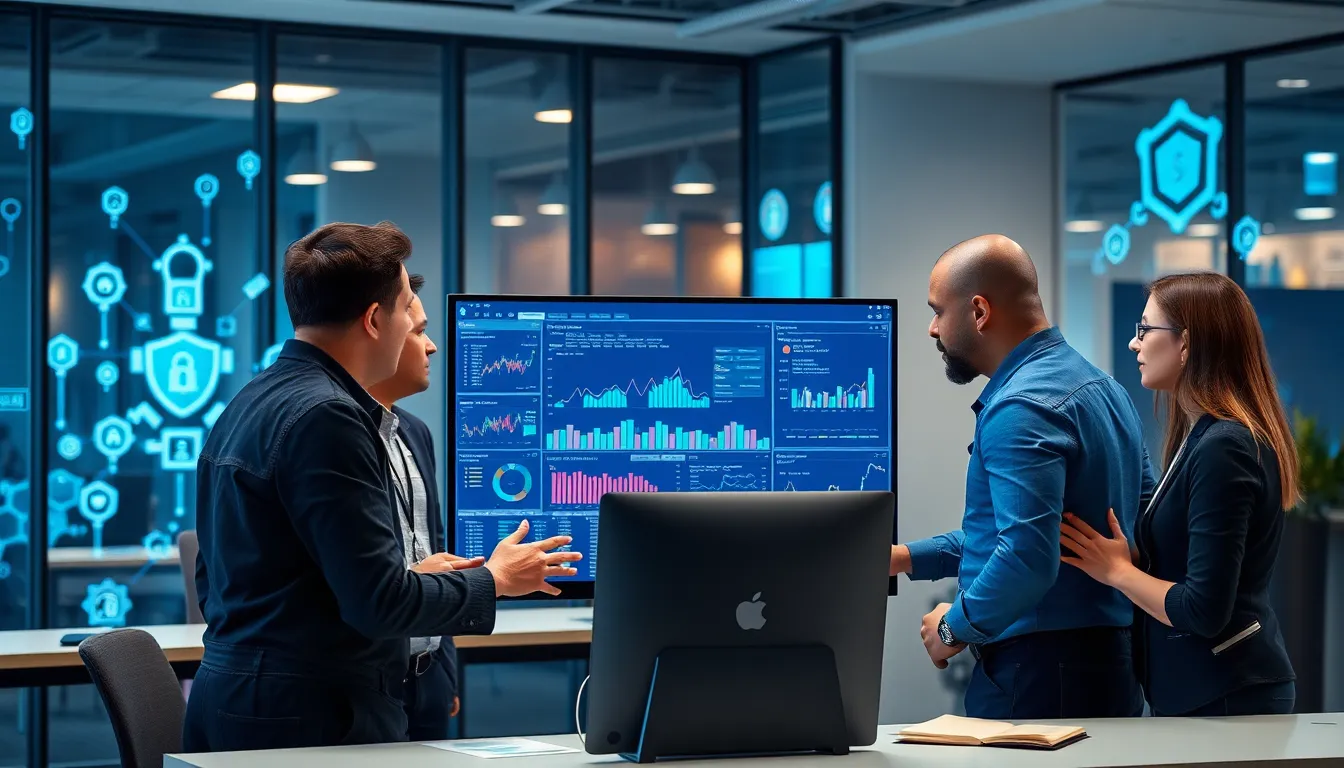In a world where cyber threats lurk around every digital corner, staying one step ahead is no longer just a luxury—it’s a necessity. Emerging technologies in cybersecurity, like the C844, are here to save the day, armed with cutting-edge solutions that make hackers think twice before attempting to breach defenses. Think of it as the superhero of the tech realm, swooping in to protect sensitive data with style and flair.
Table of Contents
ToggleOverview of Emerging Technologies in Cybersecurity – C844
Emerging technologies in cybersecurity, including C844, address rising digital threats. These innovations offer strategies to combat unauthorized access and data breaches. Machine learning plays a vital role in analyzing vast data sets for real-time threat detection. Cybersecurity frameworks continue to evolve, integrating artificial intelligence for predictive analytics.
Additionally, blockchain technology is gaining traction for its decentralized nature, enhancing data integrity and security. Quantum computing represents a revolutionary shift, posing both opportunities and challenges in encryption standards. Biometric authentication methods, such as fingerprint and facial recognition, improve identity verification processes significantly.
Smart technologies, like the Internet of Things (IoT), necessitate advanced security measures. C844 technologies provide various layers of protection against potential vulnerabilities in IoT devices. Security as a Service (SECaaS) is also growing, allowing companies to outsource their cybersecurity needs effectively.
Implementing multi-factor authentication strengthens security protocols across platforms. Cloud security solutions help safeguard sensitive information stored off-premises while maintaining compliance with regulations. Emerging technologies will reshape the cybersecurity landscape, enabling organizations to stay ahead of cybercriminals.
C844 symbolizes the forefront of these advancements, offering solutions tailored to address modern threats dynamically. The focus remains on enhancing resilience and establishing a proactive approach to cyber defense. As digital landscapes evolve, so too must the strategies and technologies used to protect them.
Current Trends in Cybersecurity

Cybersecurity continues to evolve as organizations face increasing digital threats. Emerging technologies play a vital role in defending sensitive data against cyberattacks.
Artificial Intelligence and Machine Learning
Artificial intelligence transforms cybersecurity through enhanced real-time threat detection. Machine learning models analyze vast amounts of data, identifying patterns and anomalies that indicate potential breaches. Cybersecurity solutions leverage AI to automate responses, reduce human error, and expedite incident handling. Predictive analytics allow organizations to anticipate attacks before they unfold, strengthening overall security measures. Many companies now integrate AI-based tools to further develop resilience against evolving threats.
Blockchain Technology
Blockchain technology enhances cybersecurity by providing immutable data records and seamless transactions. Its decentralized nature fosters transparency, which combats data manipulation and fraud. Organizations utilize smart contracts to automate and secure agreements, minimizing risks associated with human intervention. In addition, blockchain allows for secure sharing of information across multiple parties, ensuring integrity and authentication without reliance on centralized databases. Many industries now adopt blockchain to bolster cybersecurity measures and maintain trust among users.
Impact of Emerging Technologies
Emerging technologies significantly transform the cybersecurity landscape. Organizations leverage innovations to enhance protection against digital threats effectively.
Enhancing Threat Detection and Response
Machine learning enhances threat detection capabilities by analyzing vast data sets rapidly. Artificial intelligence excel at identifying patterns, allowing for quicker response to anomalies. Automated systems enable real-time analysis, reducing the time between detection and action. Predictive analytics help anticipate potential breaches, facilitating proactive efforts rather than reactive measures. The speed at which these technologies operate empowers cybersecurity teams to address vulnerabilities before they can be exploited. C844’s integration with these technologies epitomizes the advanced safeguards now available in cybersecurity.
Improving Data Privacy and Security
Data privacy benefits immensely from blockchain technology, which ensures data integrity through immutable records. Organizations rely on enhanced encryption methods driven by quantum computing to protect sensitive information. Biometric authentication provides a more secure way for identity verification, reducing risks associated with stolen credentials. Security as a Service (SECaaS) offerings deliver comprehensive solutions, allowing organizations to redirect focus toward core operations. Robust cloud security measures provide necessary protections, ensuring compliance with regulatory standards. Together, these innovations create a fortified environment, safeguarding data from emerging threats.
Challenges Faced by Emerging Technologies
Emerging technologies in cybersecurity, such as C844, encounter various challenges. Addressing these obstacles is essential for maximizing their potential.
Implementation Barriers
Successful integration of emerging technologies often faces obstacles. Constraints related to cost hinder many organizations. Resource availability also poses challenges, preventing effective implementation. IT staff require specialized training to utilize new tools effectively. Compliance with regulations complicates deployment, as organizations must navigate complex legal landscapes. Organizations often struggle with interoperability between legacy systems and innovative technologies.
Ethical Considerations
Ethical dilemmas arise as cybersecurity technologies evolve. Privacy issues emerge when collecting vast amounts of data for analysis. Users frequently grapple with the implications of surveillance and data usage. Trust in technology diminishes if organizations fail to communicate their data practices clearly. Balancing security needs with individual rights challenges policymakers and industry leaders. They must establish guidelines to ensure the responsible use of emerging technologies.
Future Directions in Cybersecurity
Emerging technologies continue to redefine cybersecurity strategies. Organizations increasingly rely on machine learning and artificial intelligence for real-time threat detection and predictive analytics. These tools enhance the speed and accuracy of threat identification, allowing for rapid responses.
Quantum computing emerges as a game changer for encryption standards. Traditional encryption methods face potential vulnerabilities, but quantum technologies offer solutions that strengthen data protection. Enhanced encryption methods drive a shift in industry practices, bolstering defenses against sophisticated cyberattacks.
Blockchain technology also plays a crucial role in securing data integrity. Its ability to create immutable records fosters transparency, greatly reducing risks associated with data manipulation. Organizations that adopt blockchain benefit from its enhanced security protocols.
Biometric authentication systems gain traction for identity verification processes. Fingerprint and facial recognition technologies reduce the likelihood of unauthorized access, thereby improving overall security. The integration of these systems into existing infrastructures demonstrates significant advancements in user authentication.
Security as a Service (SECaaS) rises in popularity. Outsourcing cybersecurity needs enables organizations to focus on core operations while maintaining robust protection. SECaaS providers often leverage cutting-edge technologies, ensuring clients receive top-tier security solutions.
Despite these advancements, challenges remain. Implementation costs can hinder progress, and organizations may struggle with resource availability. Specialized training for IT staff is also essential to maximize the potential of these emerging technologies.
Regulatory compliance presents another hurdle. Maintaining adherence to evolving standards complicates deployment efforts. Clear communication about data practices is vital, ensuring user trust and understanding.
Ethical considerations must guide technological adoption. Policymakers and industry leaders focus on establishing frameworks that balance security with individual rights and privacy. Responsible use of technology becomes essential in this continuously evolving landscape.
Emerging technologies are redefining the cybersecurity landscape and equipping organizations with powerful tools to combat digital threats. Innovations like C844, machine learning, and artificial intelligence offer enhanced protection and proactive measures against potential breaches. As organizations navigate the complexities of implementation and compliance, the focus on ethical considerations and user trust remains crucial.
The integration of quantum computing and blockchain further strengthens data integrity and encryption standards. With the rise of SECaaS, businesses can effectively outsource their cybersecurity needs while maintaining robust defenses. As these technologies continue to evolve, their role in shaping a secure digital future cannot be overstated. Organizations must embrace these advancements to stay ahead of cybercriminals and foster a resilient cybersecurity posture.



